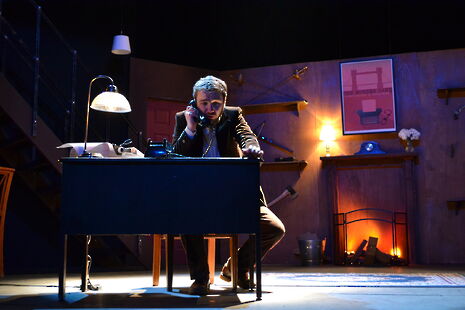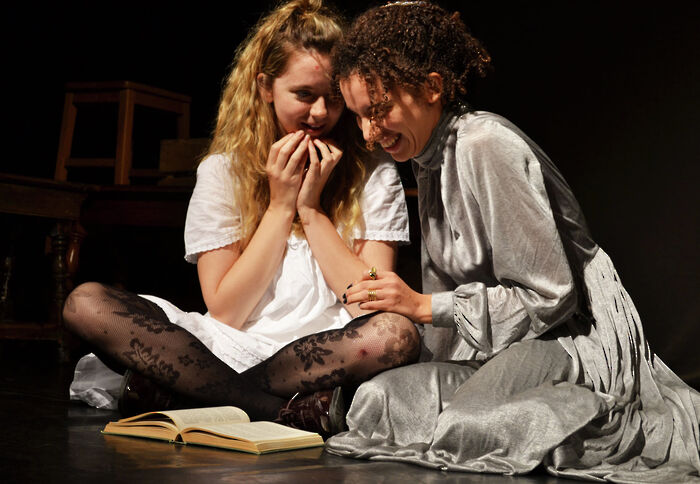Deathtrap is irresistible
Connor Rowlett’s production does an excellent job, despite having to grapple with an overly-complex plot.

Sidney ‘authour-of-The-Murder-Game’ Bruhl has seen better days, more successful days. Eighteen years after his big success, Sidney has had a string of disappointments and no fresh ideas. Until the typescript of a play written by one of his seminar students finds itself upon his desk, that is. Sidney jokes bitterly that given his career he could just do away with the student and claim the play as his own. His wife Myra convinces him rather to call the author, Clifford, and invite him round to discuss the ‘promising first draft’. When Clifford arrives, he brings the manuscript and reveals that he sent Sidney the only carbon copy. Suddenly, the joke begins to feel palpable; but is the writer of murder mystery plays capable of killing his rival?
It’s difficult to describe the somewhat ridiculous plot of Deathtrap beyond this set-up without giving away the numerous and surprising turns in the piece, and it’s difficult to give a sense of the play by only describing the (comparatively slow) opening, as it fails to explain the whole premise. Suffice it to say that that there are plays within plays, and the audience never knows whether to trust what they see. The layered conceit of the melodrama means the thriller element is not so much a ‘whodunnit?’ as a ‘will they do it?’ or a ‘has it actually been done?’.
Incidentally, I asked myself the same question about the performance; one note reads ‘is this the ending?’ and another, four lines later: ‘I think this is the ending’ - I was right the second time. I shouldn’t labour this point, because it is as much a problem with the script than with this production, but I think the technical effect (mirroring the opening) which occurred between the two scenes added to the confusion already brought on by the continually destabilising script. I can see how this may have been intended as a device which symbolised or mirrored the script’s tendency to metatheatrical suggestions, but if so it wasn’t quite successful.
“The whole cast give strong individual performances, and respond well to one another.”
Indeed, there were a few minor problems with technical effects; some light and sound effects were mistimed, one weaponry sound effect was disarmingly inaccurate, and the sounds in the storm scene, while effective in the atmosphere they created, were just too loud to hear the actors at anything less than a shout. However, these are very small issues, easily resolved by adjustments, and presumably attributable to the fact of it being opening night. Similarly forgiven was the accidental loss of a shelf in a climactic scene.
Otherwise, the set by Lydia Roe and Craig Stewart is effective - a nice touch being the visual parallel between the conspicuous poster for The Murder Game and the production’s own poster, designed by Ben James. Costumes, too, are thoroughly thought through; Christina Childs evokes the era and environment of the play’s setting, and particularly succeeds with Clifford’s costume of boots, flares, and high necks. The parallel between Clifford and Myra’s costume in key scenes was especially thoughtful, though to elaborate would be to spoil why.
The piece was visually effective, and the performances lived up to this standard. Vee Tames plays Myra with a lovely resolve which crumbles into a believable hysteria, and it would only have been nicer to see more of her; her face was often obscured by Tames’ hair, the low lighting, or the positioning of the Bruhl’s in their closer moments. Jonathan Iceton is fantastic as Clifford, his flouncing ‘artiste’ character coded in camp but managing not to stray into stereotype. Clifford’s initial naivete and growing control are well balanced, as Iceton deftly handles his changing attitudes.
Helga, a neighbour with ESP (Extra Sensory Perception), offers light relief in the form of her manic expression of psychic powers; played by Alayo Akinkugbe with an eccentricity in the model of Madame Trelawny, the contrast between Helga’s proclamations and more ordinary conversations are a highlight, as Akinkugbe switches from melodramatic emphasis to drier delivery with ease. The other comic character is Porter, Sidney’s lawyer. Porter needn’t be funny, but the decision to overplay the dullness of the character in Ben Philipps’ deliberately stilted performance made him so, and to positive effect. The whole cast give strong individual performances, and respond well to one another.
The star of the show, though, is Sidney; William Batty dominates the stage from the pre-set to the penultimate scene, and his delivery never falters. In Sidney’s first long phone call, Batty energises a one-sided conversation with mannerisms and tonal shifts which demonstrate his capability, and his performance maintains this variety and command throughout. It would be a disservice to the others on stage to say he stole the show, but Batty's performance was utterly compelling; his Sidney is unstable yet composed, arrogant yet self-aware, reprehensible yet redoubtable.
Batty and his fellow actors pitch every scene perfectly. Indeed, any problems with Deathtrap were either so minor as to be negligible or mostly the result of Levin’s plot, rather than the efforts of this production, who handle the ever-subverted script supremely well. Well-considered visuals and strong performances across the board make this a show you don’t want to miss.
 Features / Should I stay or should I go? Cambridge students and alumni reflect on how their memories stay with them15 December 2025
Features / Should I stay or should I go? Cambridge students and alumni reflect on how their memories stay with them15 December 2025 News / Cambridge study finds students learn better with notes than AI13 December 2025
News / Cambridge study finds students learn better with notes than AI13 December 2025 News / Uni Scout and Guide Club affirms trans inclusion 12 December 2025
News / Uni Scout and Guide Club affirms trans inclusion 12 December 2025 Comment / The magic of an eight-week term15 December 2025
Comment / The magic of an eight-week term15 December 2025 News / News In Brief: Michaelmas marriages, monogamous mammals, and messaging manipulation15 December 2025
News / News In Brief: Michaelmas marriages, monogamous mammals, and messaging manipulation15 December 2025








